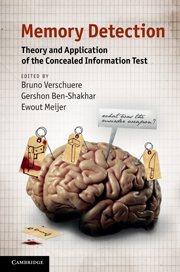Book contents
- Frontmatter
- Contents
- List of figures
- List of tables
- Notes on contributors
- Acknowledgments
- Part I Introduction
- Part II The laboratory: theoretical and empirical foundations of the Concealed Information Test
- Part III Field applications of concealed information detection: promises and perils
- 8 Limitations of the Concealed Information Test in criminal cases
- 9 Validity of the Concealed Information Test in realistic contexts
- 10 Leakage of information to innocent suspects
- 11 Countermeasures
- 12 Psychopathy and the detection of concealed information
- 13 Clinical applications of the Concealed Information Test
- 14 Daily application of the Concealed Information Test: Japan
- 15 The Concealed Information Test in the courtroom: legal aspects
- Part IV Conclusions
- Index
- References
9 - Validity of the Concealed Information Test in realistic contexts
Published online by Cambridge University Press: 05 June 2012
- Frontmatter
- Contents
- List of figures
- List of tables
- Notes on contributors
- Acknowledgments
- Part I Introduction
- Part II The laboratory: theoretical and empirical foundations of the Concealed Information Test
- Part III Field applications of concealed information detection: promises and perils
- 8 Limitations of the Concealed Information Test in criminal cases
- 9 Validity of the Concealed Information Test in realistic contexts
- 10 Leakage of information to innocent suspects
- 11 Countermeasures
- 12 Psychopathy and the detection of concealed information
- 13 Clinical applications of the Concealed Information Test
- 14 Daily application of the Concealed Information Test: Japan
- 15 The Concealed Information Test in the courtroom: legal aspects
- Part IV Conclusions
- Index
- References
Summary
Overview: Earlier field studies on the Concealed Information Test (CIT) are reviewed from a new perspective. Limitations of the studies as well as factors that account for the relatively large false negative rates are discussed. Two types of CIT practice, the pre-interrogation practice, which is mainly used in Japan, and the interrogation practice are identified and discussed. The advantages of each type of practice are described and suggestions for improvement are made.
The Concealed Information Test, also labeled the Guilty Knowledge Test (Lykken, 1959), is a method of psychophysiological detection that identifies information that knowledgeable (guilty) people do not wish to reveal and ignorant (innocent) people are unable to reveal (see Lykken, 1974, 1998).
Studies conducted in laboratory settings have indicated that the CIT is a highly valid method for differentiating between guilty and innocent participants. For example, Ben-Shakhar and Elaad (2003) conducted a meta-analysis of CIT laboratory studies using electrodermal responses and showed that under optimal conditions (i.e., using a mock crime procedure, motivational instructions, deceptive verbal response to the critical items, and at least five CIT questions) the CIT is highly efficient (i.e., the average effect size estimated under these conditions was 3.12 and the area under the ROC curve was 0.95).
However, field conditions are often less than optimal and typically differ drastically from the experimental conditions. It is therefore absolutely essential to conduct field studies that will provide a more comprehensive picture on the validity of the CIT in its forensic application.
- Type
- Chapter
- Information
- Memory DetectionTheory and Application of the Concealed Information Test, pp. 171 - 186Publisher: Cambridge University PressPrint publication year: 2011
References
- 2
- Cited by

